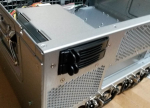darrenbest
Dabbler
- Joined
- Apr 7, 2012
- Messages
- 33
The revised Hardware Guide is great to see, as I am currently specing out my system.
It is advising against any longer using a USB flash drive as a boot device, instead recommending an SSD. In my case, the board I'm going with (Supermicro X11SSM-F) has 8 SATA ports, and I'm going to have 8 spinning drives. The board also has no on-board NVMe slot. (I had been assuming I'd be using the board's internal USB port for a flash drive.)
However, there are 4 PCI-e slots that I had no intention of using. There are very cheap PCI-e adapters on Amazon that allow you to mount an NVMe SSD on the card. Anyone know if this Supermicro board will have any issues booting off a drive installed in this manner?
Thanks!
It is advising against any longer using a USB flash drive as a boot device, instead recommending an SSD. In my case, the board I'm going with (Supermicro X11SSM-F) has 8 SATA ports, and I'm going to have 8 spinning drives. The board also has no on-board NVMe slot. (I had been assuming I'd be using the board's internal USB port for a flash drive.)
However, there are 4 PCI-e slots that I had no intention of using. There are very cheap PCI-e adapters on Amazon that allow you to mount an NVMe SSD on the card. Anyone know if this Supermicro board will have any issues booting off a drive installed in this manner?
Thanks!

